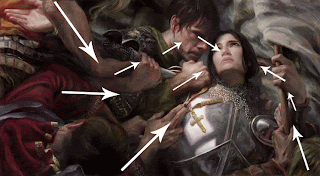Principles of Design (part 1)
1.) Unity
unity, or what can also be thought of as harmony is the presence of congruence, beyond mere chance in the composition of a pice of art. unity can be achieved in a verity of ways. most commonly unity is achieve through repetition. The repetition of shape, value, line, color ect. Unity can also be achieved thought proximity or placement of object. object place closed together or overlapping have a sense of unity, while object that are distint from one another have disunity. here are a ver images to help illustrate the principle of illusion
Here we have unity through repetition of shape. even thought there are a variety of colors, unity is created through repetition of the circular shape.
This image represents unity through the repetition of the color green, even though there are differing shapes.
Here we have unity created in the lower right corner through proximity/ grouping. the circle in the top left feels out of place do to it placement far away from the rest of the circles.
Emphasis:
The attract of a viewers attention to the intended ares of an object. Emphasis can be created in a number of ways: Contrast, Isolation, and placement. there also can be a hierarchy of emphasis with one object having the major emphasis and other objects with varying degrees of emphasis.
Emphasis through value: the ; light value circle gets more attention then the dark value circles.
emphasis through isolation
(joan of arc, Donato Giancola)
emphasis through placement: the women's face gets the emphasis in this picture due to it placement. the arrows are to show that the face is placed and that all other lines and shapes flow to the face creating emphasis.
Scale/Proportion:
Scale/Proportion refers to relative size- size measured against other element or some mental norm or standard. scale can also refere to the physical proportion of the art created.








No comments:
Post a Comment